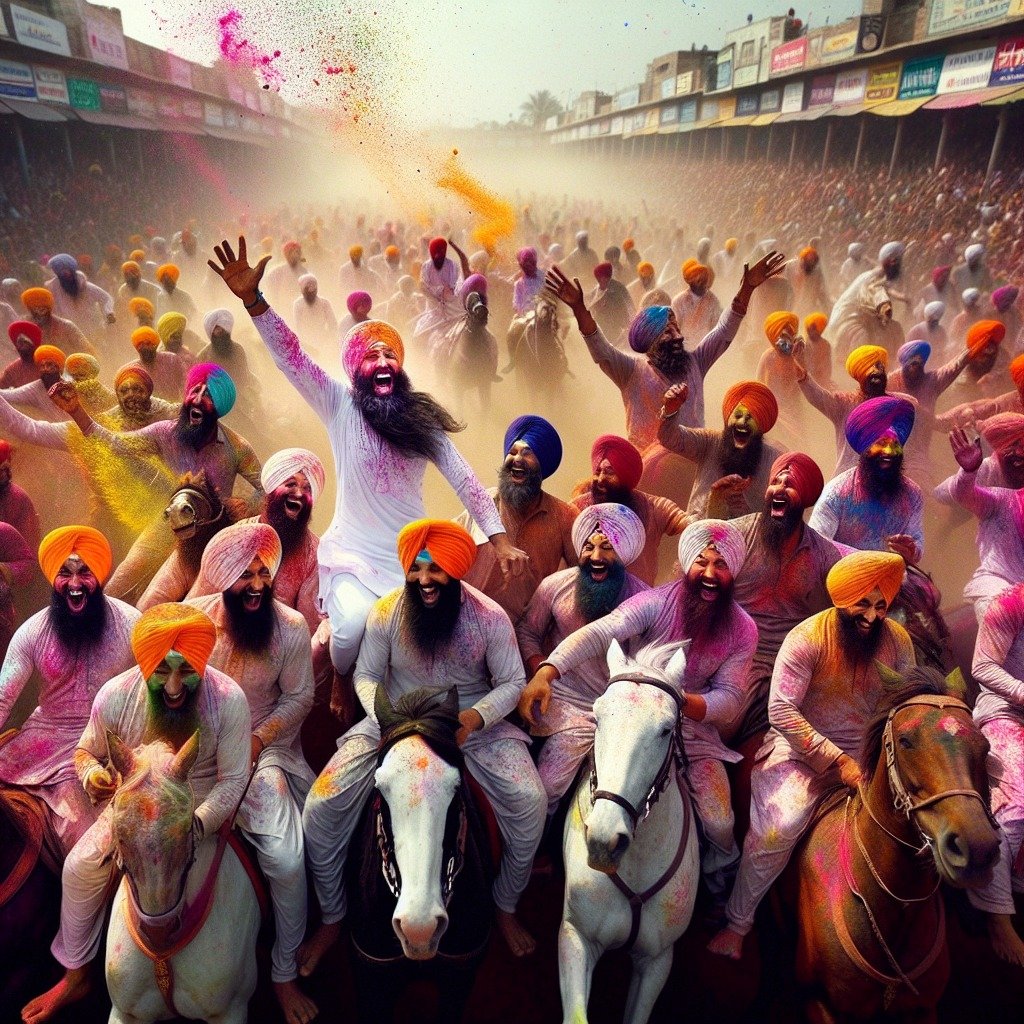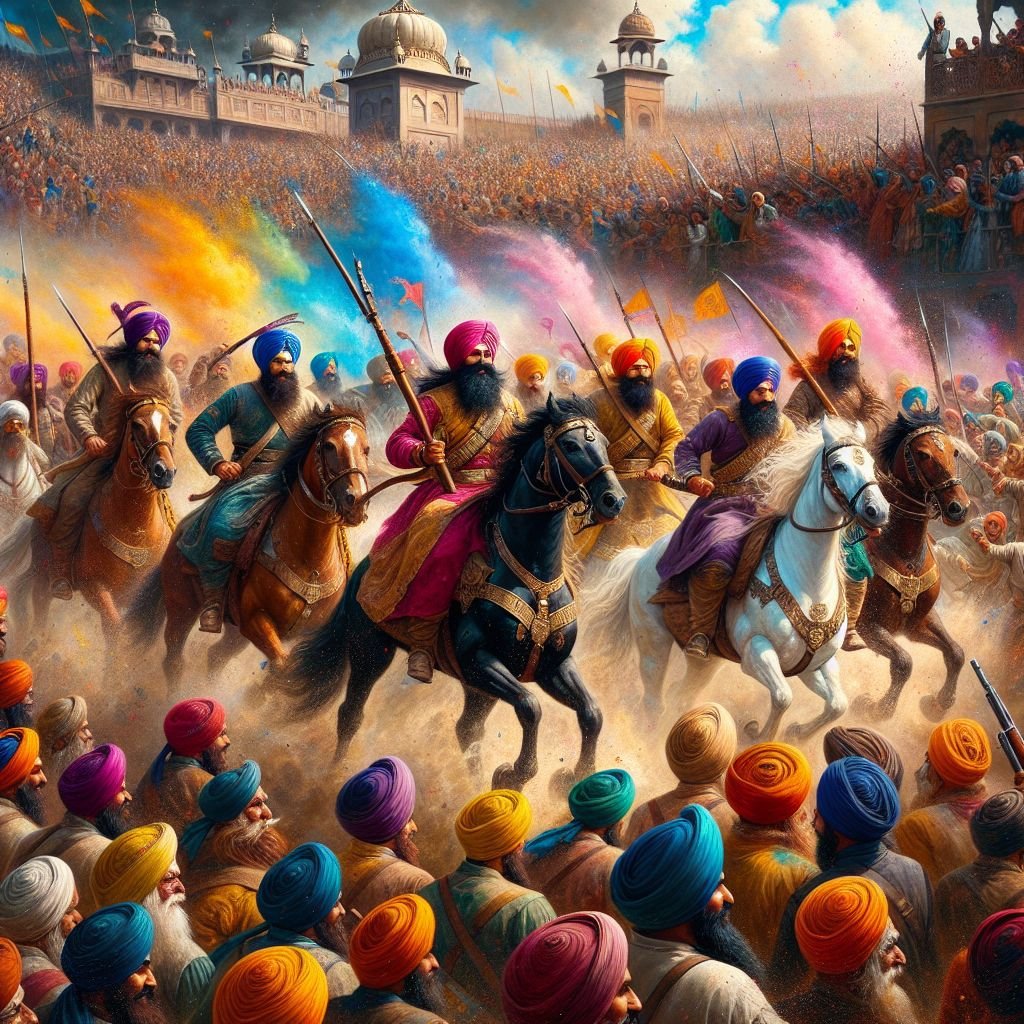Origins and Significance
Hola Mahalla, an exuberant Sikh festival, traces its genesis to the hallowed grounds of Takht Shri Anandpur Sahib, the birthplace of Khalsa. Established by Guru Gobind Singh Ji Maharaj in 1701, this tradition emerges as a beacon of courage and resilience in the face of adversity. By ingeniously aligning Hola Mahalla with the Hindu festival of Holi, Guru Sahib imbued it with a profound sense of purpose, transforming it into a celebration of Sikh martial spirit.
Military Exercises and Mock Battles
Rooted in the tradition of mock battles and military exercises, Hola Mahalla echoes with the clangor of swords and the thunder of hooves. At its heart lies the valorous display of Gatka, tent pegging, and bareback horse-riding, where Sikhs showcase their prowess and bravery. This spectacle not only honors the martial traditions of the past but also serves as a rallying call for unity and strength in the face of contemporary challenges.

Cultural Celebrations
Beyond the martial fervor, Hola Mahalla transcends into a cultural extravaganza, pulsating with the rhythms of kirtan, music, and poetry. Communities converge to revel in their shared heritage, fostering a sense of camaraderie and belonging. The festival becomes a tapestry of vibrant colors and joyous melodies, weaving together the diverse threads of Sikh identity.
Spiritual Reflections Through Poetry
In the verses of Guru Arjan Dev Ji and Bhagat Ravi Das Ji, the spiritual essence of Hola Mahalla finds expression. These timeless words speak of divine love as the eternal hue that transcends the fleeting colors of worldly attachments. Thus, amidst the festivities, Hola Mahalla becomes a sanctuary for introspection and spiritual renewal, reminding devotees of the enduring peace found in divine connection.
Message of Eternal Love
Ultimately, Hola Mahalla encapsulates a profound message of seeking eternal love—a love that surpasses the trials and tribulations of mortal existence. It beckons devotees to fill their lives with the permanent colors of spiritual devotion, leading to eternal peace and bliss. In a world marked by transience, Hola Mahalla stands as a testament to the enduring power of love and unity.

Hola Mahalla’s Evolution
Hola Mahalla – the martial origins
The term “Hola Mahalla” is steeped in linguistic heritage, combining “mohalla,” signifying an organized procession, with “hola,” denoting the charge of an army. This etymology underscores the festival’s martial origins and its evolution into a celebration of Sikh valor and solidarity.
History
Emerging from the fertile soil of Anandpur Sahib, Hola Mahalla finds its roots in Guru Gobind Singh Ji’s visionary leadership. It builds upon the tradition of Holi, infusing it with a martial spirit to inspire the Sikh nation in the face of adversity. Over the centuries, it has evolved into a grand spectacle, celebrated with fervor and reverence.
Celebration of Festivities and Customs
From its humble beginnings in Anandpur Sahib, Hola Mahalla has grown into a global phenomenon, with festivities spanning three days. The tradition of mock battles and martial displays continues to be a hallmark of the festival, symbolizing unity and readiness among the Sikh community. Additionally, the throwing of colors remains a cherished custom, symbolizing joy and camaraderie.
Hola Mahalla unfolds on the second day of the lunar month of Chet, usually in March, attracting Sikhs from all corners of the globe. The festival serves as a platform for showcasing martial skills, cultural expressions, and spiritual devotion. From Anandpur Sahib, the City of Bliss, to Gurdwaras worldwide, Hola Mahalla leaves an indelible mark on the hearts and minds of devotees.
Hola Mahalla’s Enduring Legacy
In conclusion, Hola Mahalla stands as a testament to Sikh valor, unity, and spiritual devotion. Through its vibrant celebrations, profound rituals, and enduring customs, the festival continues to inspire and uplift devotees across generations. As communities come together to honor their heritage and embrace the message of eternal love, Hola Mahalla remains a vibrant expression of Sikh identity and resilience.
















Add comment